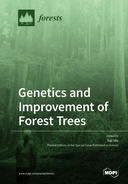Explore

Genetics and Improvement of Forest Trees
Yuji Ide (editor)
2021
0 Ungluers have
Faved this Work
Login to Fave
Forest tree improvement has mainly been implemented to enhance the productivity of artificial forests. However, given the drastically changing global environment, improvement of various traits related to environmental adaptability is more essential than ever. This book focuses on genetic information, including trait heritability and the physiological mechanisms thereof, which facilitate tree improvement. Nineteen papers are included, reporting genetic approaches to improving various species, including conifers, broad-leaf trees, and bamboo. All of the papers in this book provide cutting-edge genetic information on tree genetics and suggest research directions for future tree improvement.
This book is included in DOAB.
Why read this book? Have your say.
You must be logged in to comment.
Rights Information
Are you the author or publisher of this work? If so, you can claim it as yours by registering as an Unglue.it rights holder.Downloads
This work has been downloaded 123 times via unglue.it ebook links.
- 123 - pdf (CC BY) at Unglue.it.
Keywords
- AMOVA
- amplicon sequencing
- AmpliSeq
- ancient tree
- Bamboo
- Breeding
- breeding cycle
- Bursaphelenchus xylophilus
- C. fortunei
- Camellia oleifera
- candidate genes
- central-marginal hypothesis
- Chinese fir
- chlorophyll fluorescence
- cline
- conifer
- Conservation
- cpDNA
- Cryptomeria japonica
- Cryptomeria japonica var. sinensis
- cumulative drought stress
- cumulative temperature
- demographic history
- differentially expressed genes
- early selection
- epigenetics
- EST-SSR markers
- Eucalyptus clones
- Flavonoids
- forest tree breeding
- genetic conservation
- genetic diversity
- genetic management
- genomic prediction models
- genomic selection
- genotype by environment interaction
- genotype × environment interaction
- genotyping
- gibberellin
- heartwood
- high-throughput phenotyping
- In/Del
- infrared thermography
- inoculation test
- IRAP
- Japanese black pine
- Japanese cedar (Cryptomeria japonica)
- leaf senescence
- linkage map
- local adaptation
- LTR-retrotransposon
- male sterility
- male strobilus induction
- marker-assisted selection
- mast seeding
- molecular markers
- multiplexed SNP genotyping
- multisite
- n/a
- next generation sequencing
- northern limit
- nucleotide diversity
- phenylpropanoid metabolism
- Phyllostachys
- phylogeny
- physiological characterization
- Pinaceae
- pine wilt disease
- pine wood disease
- pine wood nematode
- pine wood nematode-Pinus thunbergii resistant trees
- Pinus thunbergii
- population structure
- populations structure
- quantitative trait locus
- RAD-seq
- Reference, information & interdisciplinary subjects
- Research & information: general
- resistance to pine wood nematode
- Sakhalin fir
- secondary metabolites
- seed production
- seed zone
- senescence-associated genes
- Silviculture
- SNP
- spatial autocorrelation error
- specific leaf area
- SSR
- stomatal characteristics
- sub-boreal forest
- thema EDItEUR::G Reference, Information and Interdisciplinary subjects::GP Research and information: general
- thinning
- Thujopsis dolabrata
- trailing edge population
- transcriptome
- transcriptome analysis
- tree improvement program
- Ty1-copia
- Ty3-gypsy
- variance component
- Varieties
- water relations
- water stress
- widely targeted metabolomics
Links
DOI: 10.3390/books978-3-0365-1243-3Editions

